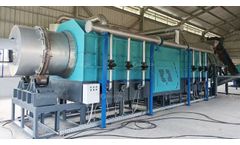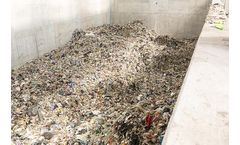gasification process Articles
-
Energetic and exergetic performance assessment of some coals in Turkey for gasification process
This paper undertakes a study on energetic and exergetic performance evaluation of various types of coals in Turkey, such as Armutcuk, Amasra, Zonguldak and Catalagzy hard coals and Tuncbilek, Beypazari, Cayirhan, Afsin, Soma, Yatagan, Can and Sorgun lignites for gasification purposes, where syn-gas may subsequently be used for the production of electricity, heat, hydrogen, etc. in industry. The ...
-
Research on gasification process of loose biomass material with oxygen-enriched air in fluidised bed gasifier
Fluidised bed gasification technology with oxygen-enriched air suitable for gasifying loose biomass materials was developed. Gasification experiments with different biomass materials such as rice straw, rice hull, wheat straw, sawdust and municipal wastes, were carried out. The tests showed that biomass materials can be gasified continuously at a temperature between 600 and 750°C. The heating ...
-
Biomass Gasification and Gas Analyzers: Unlocking the Future of Clean Energy
Introduction In the current climate change environment, finding clean energy alternatives to traditional fossil fuels has become crucial. Biomass gasification technology has become a high-profile energy production method, which converts biomass waste into syngas that can be used for power generation, heating and fuel production. However, to use this technology effectively we need to accurately ...
-
Analysis of the organic contaminants in the condensate produced in the
in situ underground coal gasification processAddressing the environmental risks related to contamination of groundwater with the phenolics, benzene, toluene, ethyl benzene, xylene (BTEX) and polycyclic aromatic hydrocarbons (PAHs), which might be potentially released from the underground coal gasification (UCG) under adverse hydrogeological and/or operational conditions, is crucial in terms of wider implementation of the process. The aim ...
-
The Deutsches EnergieRohstoff-Zentrum Freiberg: advanced prospects for applied organic petrology, focused on the generation of coal based chemical products
The Deutsches EnergieRohstoff-Zentrum Freiberg (DER) is a strategic partnership between government, science and industry to develop innovative concepts and technologies for the peak and post oil era. Researchers and practitioners collaborate to develop technical innovations to make the energy sources coal and biomass sustainable and future-oriented. The centre addresses the issues of energy ...
-
No Pipeline for Renewable Natural Gas Projects? No problem. Use Virtual Pipeline Technology
On site biogas production Biogas can be produced from various organic resources of which the most common are agricultural waste, municipal waste, landfills, and wastewater treatment facilities. But biogas upgrading is also very much applicable in the (food & beverage) industry. Through biogas upgrading, trace impurities and carbon dioxide (CO2) in raw biogas are separated from methane (CH4) ...
-
Exergetic performance assessment of gasification and pyrolysis processes of pre-treated wood board wastes
This paper investigates exergetic performance of gasification and pyrolysis processes and compares their exergy efficiencies, using the experimental data on a two-step process of thermo-chemical conversion of Wood Board (WB) wastes. The exergy values of biomass samples change from 17.49 MJ/kg to 24.57 MJ/kg, respectively. Hydrogen produced from pyrolysis step of gasification varies between 17 ...
-
Using Venturi Scrubber Technology for Syngas Cleaning
As part of our nation's program to reduce dependence on fossil fuels, various gasification technologies are being applied. These processes take renewable organic material and, through the application of heat and pressure, convert the materials into syngas for further use. Arguably, in nearly all of these processes, the most critical design aspect is the reliable and efficient removal of ...
-
Solid waste gasification pollution abatement - Case study
Catalytic Products International has partnered with a Gasification System Designer in the design and supply of a unique thermal oxidizer for use with a closed loop batch pyrolysis gasification system. The gasifier is engineered to create a clean combustible syngas from a broad spectrum of dissimilar carbonbased solids, liquids, and other feedstocks. The QUADRANT NR – SEVERE DUTY Thermal ...
-
The Deutsches EnergieRohstoff–Zentrum Freiberg: advanced prospects for applied organic petrology, focused on the generation of coal based chemical products
The Deutsches EnergieRohstoff–Zentrum Freiberg (DER) is a strategic partnership between government, science and industry to develop innovative concepts and technologies for the peak and post oil era. Researchers and practitioners collaborate to develop technical innovations to make the energy sources coal and biomass sustainable and future–oriented. The centre addresses the issues of energy ...
-
Following the fuel: How portable biomass energy generation may help rural communities
The forests that surround many of California’s mountain communities tend to have an abundance of woody biomass and a pressing need for thinning to reduce fire danger. Revenue from selling forest residues to biomass power plants could help to support fuel reduction activities, but in many cases the nearest plant is so far away that hauling costs are prohibitive. The remoteness of such ...
-
What You Need To Understand The Processes Of The Biomass Pyrolysis Plant
Pyrolysis is referred to as a thermal decomposition related to biomass which takes place in an environment where oxygen is absent. This chemical reaction can be a precursor both for gasification and combustion processes that naturally occurs in just a matter of moments. Products produced through biomass pyrolysis range between bio-oil, to biochar, onto gases which include fractional co2, deadly ...
-
Wood Charcoal Making Machine - How to Make Charcoal from Wood
In the realms of sustainable energy and resource utilization, the evolution of charcoal production stands as a testament to human ingenuity. Over the years, the art of transforming wood into charcoal has not only preserved ancient cooking and heating traditions but also carved a niche in modern industrial processes. In this discourse, we delve into the intricacies of the wood charcoal making ...
-
Green Energy GEE, China - Case Study
Using a PP20 v5 and working with university partners, Shenzhen Green & clear world Environmental Engineering (GEE) is developing a syngas-to-liquid reactor. Focusing on the commercialization of environmentally responsible projects, GEE's Power Pallet is part of a program to process municipal solid waste (MSW) into a transportation fuel. They are working to integrate their system into the ...
-
What You Need To Understand About The Processes Of Your Biomass Pyrolysis Plant
Pyrolysis is known as a thermal decomposition associated with biomass which occurs in an environment where oxygen is absent. This chemical reaction is really a precursor for both gasification and combustion processes that naturally occurs in just a couple of seconds. Products produced through pyrolysis with biomass pyrolysis plant vary from bio-oil, to biochar, onto gases that come with co2, ...
-
Measuring Gases Produced by Waste Gasification to Improve Control and Efficiency
Waste gasification is a type of waste to energy process where waste material is used as a fuel to create heat, electricity or other chemical products. Specifically, in waste gasification, the waste material is decomposed in such a way to produce gaseous products, often known as syngas, a combination of hydrogen, carbon monoxide and some carbon dioxide.1 Conventional incineration uses heat and ...
-
Cleaning Up Gasification Syngas
Documento sin título Introduction By definition, gasification is the art of changing a non-gaseous substance, such as a liquid or a solid, into a gas. By this definition, processes such as combustion, anaerobic digestion and pyrolysis would be classified as gasification. However, in today’s world, gasification is defined as any process, which produces a “synthesis gas” or a ...
-
TAIM WESER, at the forefront in biomass cogeneration solutions
The state-of-the-art biomass gasification plant, developed by TAIM WESER utilizing proprietary technology, is now up and running successfully, joining the range of technological products offered by the company. This solution offers clients high energy efficiency, streamlined processes and a design that, owing to its compact dimensions, allows the equipment to be installed at the location where ...
-
Bolivar wastewater treatment plant cogeneration facility to be Installed by Clarke Energy - Case Study
The Bolivar Wastewater Treatment Plant (WWTP) is the largest wastewater treatment plant in the Adelaide region, processing almost 70% of Adelaide’s metropolitan wastewater. The South Australian Government has approved a $25.8 million project for SA Water to optimise the energy utilisation on the site. This project will provide a major upgrade to the WWTP power supply by the installation of ...
-
South Tyrol 03 - ZE-50-ULH - Pyrolitic Gasification and Engines Syngas-Fueled Genset - Case Study
Plant: 1 x ZE-50-ULH Low-Temperature Organic Rankine Cycle (ORC) Module, nominal output 50 kWe Nominal output: 50 kWe Application: Heat recovery from processes (pyrolitic gasification) and engines (syngas-fueled genset) Location: Province of Bolzano/Bozen, South Tyrol, Italy Manager: Private Italian firm The client who commissioned this plant is an ad-hoc enterprise located in a suburb of ...
Need help finding the right suppliers? Try XPRT Sourcing. Let the XPRTs do the work for you


